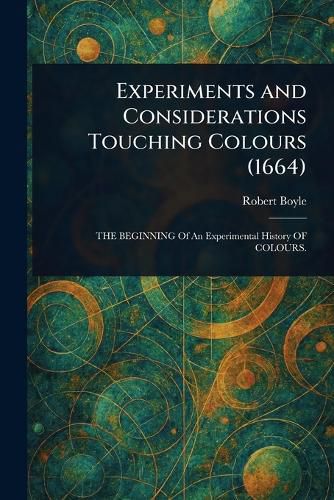Readings Newsletter
Become a Readings Member to make your shopping experience even easier.
Sign in or sign up for free!
You’re not far away from qualifying for FREE standard shipping within Australia
You’ve qualified for FREE standard shipping within Australia
The cart is loading…






This title is printed to order. This book may have been self-published. If so, we cannot guarantee the quality of the content. In the main most books will have gone through the editing process however some may not. We therefore suggest that you be aware of this before ordering this book. If in doubt check either the author or publisher’s details as we are unable to accept any returns unless they are faulty. Please contact us if you have any questions.
Explore the fascinating world of color through the eyes of 17th-century scientist Robert Boyle in "Experiments and Considerations Touching Colours." This meticulously prepared edition presents Boyle's groundbreaking investigations into the nature of color, blending early scientific inquiry with elements of optics, physics, alchemy, and chemistry.
Delve into a series of experiments that seek to unravel the mysteries behind the hues we perceive. Boyle's work offers a unique perspective on color theory, reflecting the scientific understanding of his time. This volume provides a window into the historical development of scientific thought. It is a valuable resource for anyone interested in the history of science, experimental methods, or the early study of chemistry and physics. Discover the enduring relevance of Boyle's considerations on color and its fundamental role in our understanding of the natural world.
This work has been selected by scholars as being culturally important, and is part of the knowledge base of civilization as we know it.
This work is in the public domain in the United States of America, and possibly other nations. Within the United States, you may freely copy and distribute this work, as no entity (individual or corporate) has a copyright on the body of the work.
Scholars believe, and we concur, that this work is important enough to be preserved, reproduced, and made generally available to the public. We appreciate your support of the preservation process, and thank you for being an important part of keeping this knowledge alive and relevant.
$9.00 standard shipping within Australia
FREE standard shipping within Australia for orders over $100.00
Express & International shipping calculated at checkout
This title is printed to order. This book may have been self-published. If so, we cannot guarantee the quality of the content. In the main most books will have gone through the editing process however some may not. We therefore suggest that you be aware of this before ordering this book. If in doubt check either the author or publisher’s details as we are unable to accept any returns unless they are faulty. Please contact us if you have any questions.
Explore the fascinating world of color through the eyes of 17th-century scientist Robert Boyle in "Experiments and Considerations Touching Colours." This meticulously prepared edition presents Boyle's groundbreaking investigations into the nature of color, blending early scientific inquiry with elements of optics, physics, alchemy, and chemistry.
Delve into a series of experiments that seek to unravel the mysteries behind the hues we perceive. Boyle's work offers a unique perspective on color theory, reflecting the scientific understanding of his time. This volume provides a window into the historical development of scientific thought. It is a valuable resource for anyone interested in the history of science, experimental methods, or the early study of chemistry and physics. Discover the enduring relevance of Boyle's considerations on color and its fundamental role in our understanding of the natural world.
This work has been selected by scholars as being culturally important, and is part of the knowledge base of civilization as we know it.
This work is in the public domain in the United States of America, and possibly other nations. Within the United States, you may freely copy and distribute this work, as no entity (individual or corporate) has a copyright on the body of the work.
Scholars believe, and we concur, that this work is important enough to be preserved, reproduced, and made generally available to the public. We appreciate your support of the preservation process, and thank you for being an important part of keeping this knowledge alive and relevant.